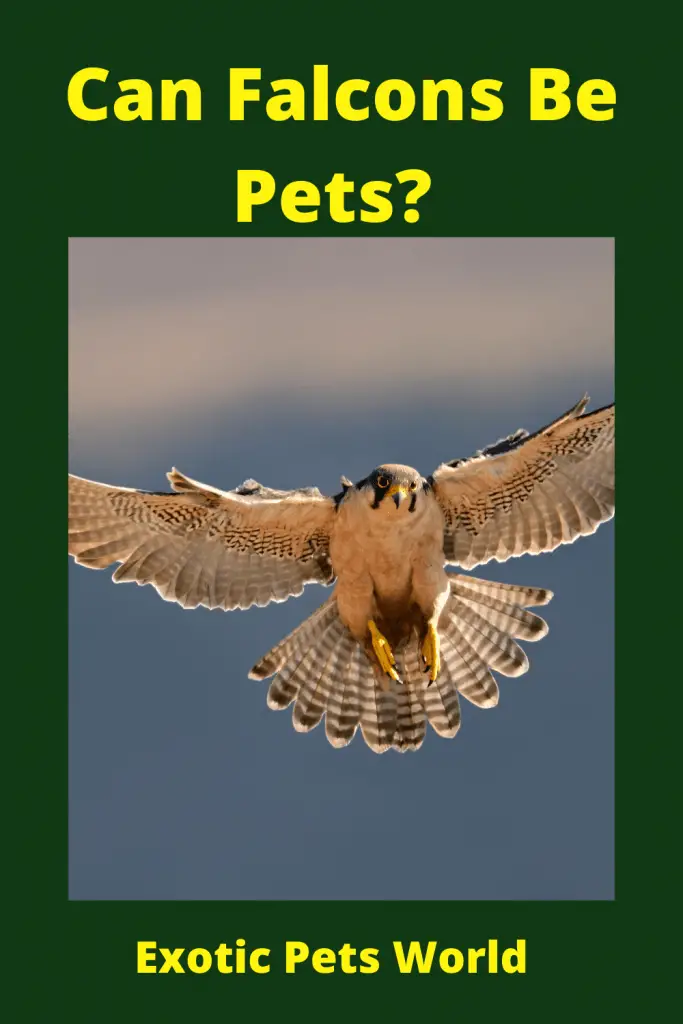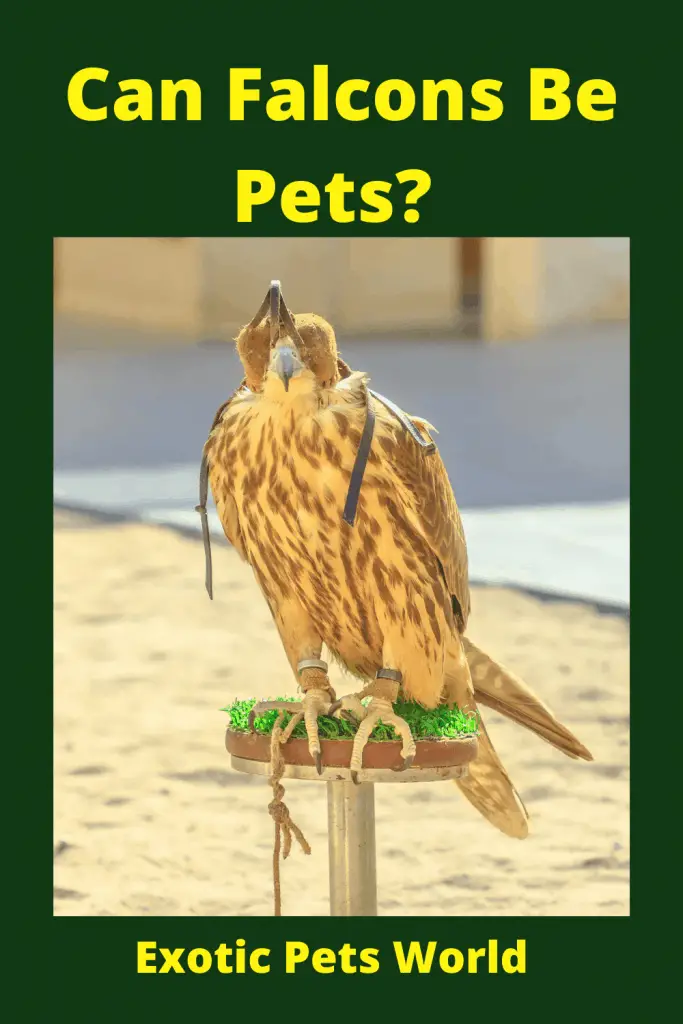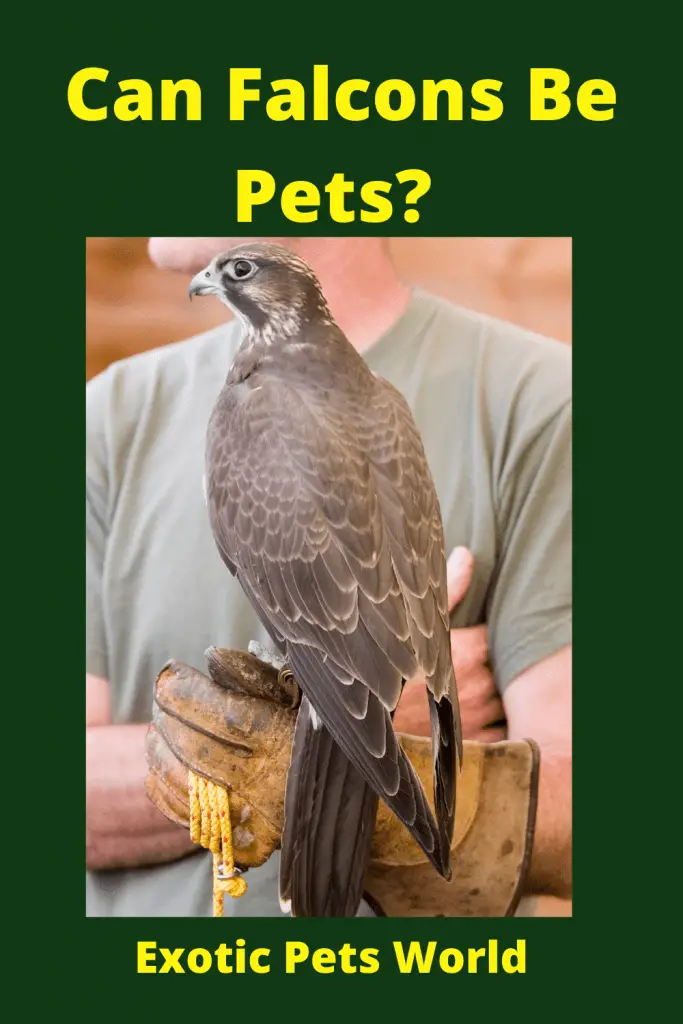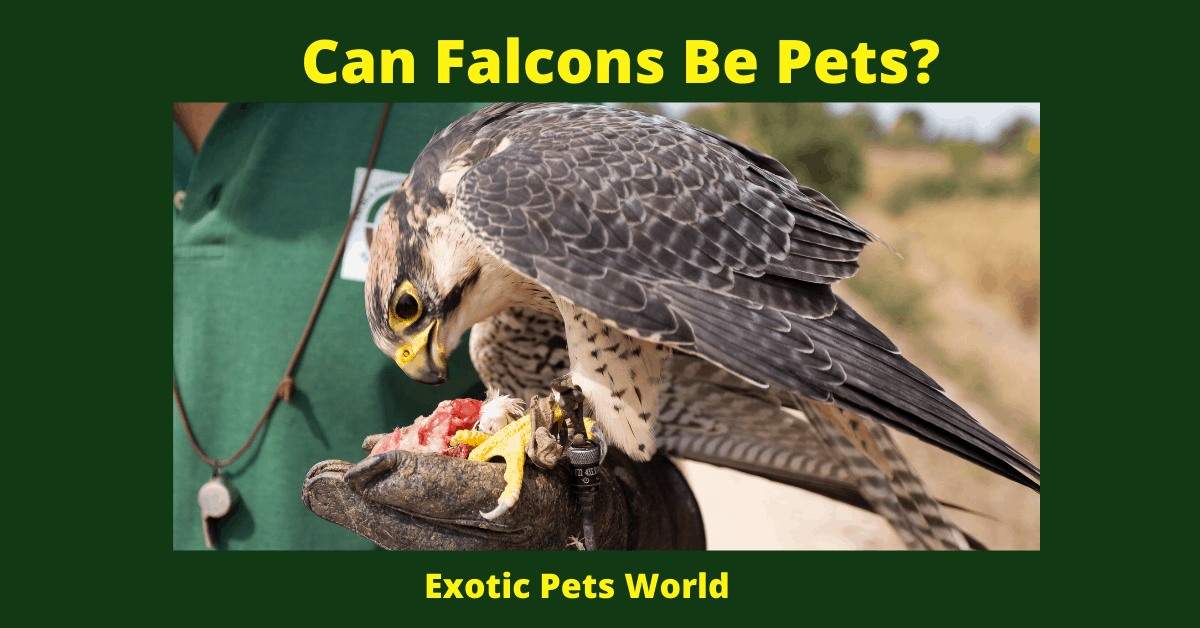Can Falcons Be Pets? Falcons are birds of prey or raptors, with sharp curved beaks and sharp talons on their feet. They are extremely skilled predators with wings, and their thin and beautiful wings enable them to maneuver correctly in the air. There are more than 41 different species of Falcons. All are in the taxonomic genus Falco. Read more to learn everything about the Falcons.
Can Falcons Be Pets / Falcon Species/Types of Falcons
Different types of falcons live in almost every landmass. The only areas where these birds do not live are in the Arctic Circle and northern Antarctica. These birds live throughout Central, North, South America and Africa, Eurasia, Australia, and the surrounding islands.
The diversity of species is much greater in South America and Africa than in other areas. Each species has its specific features, although many species have overlapping populations due to inter-specie breeding.
Falcons vary in size and plumage, but they physically look alike. All of these species have narrow wings for better maneuvering through the air. Most species have gray, white, tan, black, or brown feathers.

There is a lot of size variation in Falcons. Some are extremely large, and some are relatively small. The smallest species is only 11 inches long, while the largest is 25 inches long. These heaviest birds weigh more than four pounds/1.81 kg, while the smallest species weigh only 1 ounce.
There are many different types of falcons, and each one is different from the next. Below, we highlight some most common and exciting species in the Falcon family.
Seychelles Kestrel:
These Falcons are just 11 inches long, making them the smallest Falcons. These little birds live only in the Seychelles Islands of Africa. Seychelles is in danger of extinction due to the island’s endemic diseases. So, IUCN adds them to the endemic species vulnerable to extinction.
Gyr Falcon:
One of the largest members of the Falcon family is known as Gyr Falcon. They are about 2 feet long, and their weight is usually more than 4 pounds because they are huge. They can prey on a wide variety of animals and birds, from rabbits and gulls to other small birds.
Peregrine Falcon:
This species is the fastest bird on Earth. Although they are very fast when flying in the air via wings, they reach their maximum speed during diving. During a dive, sometimes this bird travels 200 miles per hour or more! They use these dives to catch their prey before they know what happened to them.
Saker Falcons:
These birds live throughout North Africa, Europe, the Middle East, and Asia. Sadly, this species is also endangered, and the IUCN has listed the Soccer Falcon as extremely endangered. Some of their most serious threats are habitat destruction and collisions with power lines that result in electrocution and death

Can Falcons Be Pets?
Falcons are Not Good Pets. But in some countries like the US, UK, France, etc., you have to take proper training and license to make them pets. But in UAE, India, Pakistan, etc., you do not have to take any permission or license to pet these beautiful creatures.
Is it legal in the United States?
Yes, it is legal but under some terms and licenses. In the United States, Falconry requires both state and federal licenses to operate.
There are three possible ways given below from which you can own a pet Falcon in the US:
- Zoos and educational institutions are allowed to have falcons in captivity for entertainment or educational purposes
- “Rehabbers” that have obtained special licenses for “education” birds, which must be unreleasable (i.e., there is something wrong with it)
- Falconers.
Proper licensing
Local authorities regulate Falconry in most countries/areas. In the United States, your state’s Department of Sports and Fish can provide you with all the details. Elsewhere, contact your wildlife, local game, or hunting regulatory body for specific information.
There are three levels of license:
- Beginner
- General
- Master
General & Master Falconers are allowed to choose from a variety of Falcons/raptors. These Falconers can also hold more than one raptor if they provide housing, care, and all other requirements to these birds
For a Beginners’s license, one must pass a written test. A passing score is usually 80%. The North American Falconers Association recommends reading The Falconry Manual to prepare you for the test. After obtaining the beginner’s permit, you will need to find an apprenticeship.

Apprenticeship
A beginner has to find an established Falconer to support and sponsor their apprenticeship. If you know someone who is a practicing Falconer, that is great. If you don’t find any sponsor on your own, you can usually find a sponsor through institutions or organizations like the North American Falconers Association.
Apprentices typically have to start with one passage. A passage is the Falcon or Raptor under the age of one year who has learned to fly.
Apprenticeships require at least two years, so make sure you’re ready for that commitment before asking anyone for their time and skills. During this time, the apprentice should be educated about Falconry’s techniques and ethics, gain some experience, and hopefully make friendly relations with his/her sponsor.
Total Expenses (Licensing plus Falcons)
Once you pass all these frustrations and your license exam (which cost more than $250), you are allowed to get a bird of prey, i.e., a Falcon. Falcons usually cost no less than $1,100. Some are much more expensive. But the cost of the birds will not be your only expense.
First, you need to find a professional veterinary doctor who can treat the Falcons. Then you will need outdoor perches (up to $200), Falconry gloves, creances, bracelets and jesses, and hoods (another $1000), a regular veterinarian check (About $150), some specific emergency medical equipment (about $ 500), and the cost on food (which is also not less). Falcons are usually fed quail. Quail typically run at about $2.50 each, and a bird will eat one a day. You will need a freezer (Another $ 500) for all these quails. You will also need telemetry to track your Falcons. So, before buying a Falcon, consider all these prices.
What is Falconry?
Falconry includes the capturing, training, and housing of birds of prey for use in hunting such as Falcon.
It looks a bit scary, but you are using birds to hunt. Both falcons and hawks are commonly used. Falconers can catch birds in the wild or buy them from breeders. Details about effective nets and traps to capture wild falcons can be found in books and manuals, or you learn them from experts.
It can be gratifying to invest time and effort in catching these birds. These Falcons or Hawks are trained to hunt and obey. It is possible to keep a bird just for the sake of flying, except for the hunting aspect, but not everyone thinks it is appropriate. These Raptors have a natural desire to hunt, so let them do that.
History of the Falconry
Evidence shows that the Falconry was practiced in almost every part of the world in ancient times. Mongolian soldiers practiced Falconry during military campaigns to provide food and entertainment between battles. The Falconry was used as a symbol of status in China and a symbol of military power in Japan.
The Falconry was very popular in medieval Europe, where it was often an integral part of a nobleman’s education and was enjoyed by both kings and the common man. Shakespeare also practiced Falconry and mentioned it multiple times in his plays.
Although the use of firearms in sports and hunting has become more popular, which reduce the Falconry, there is no reason why men cannot enjoy the sport today.
Is a Falcon a Good Pet?
Falcons, these birds are not good pets. Owning one requires many different forms, permits, and caging/enclosure inspections. You must also have numerous years of experience in Falconry before you can apply for a license yourself. It is illegal to capture, own, harass or kill a Falcon without a proper permit or license.
If what you want is the presence of hunting, let’s not dance around the subject. They are relatively calm and quiet, but they are the most lethal weapons for prey.

All That Being Said, you will rapidly discover that 80 percent of all Falcon care involves scraping poop off things.
Are Falcons Affectionate?
They’re not even incredibly affectionate towards us, at least not in the way that people think of affection. The Falcon’s preference to one handler or the other is based mostly on how familiar the owner is with their birds. Falcon-Owner bond or trust-related matters.
How to Raise a Falcon?
To raise Falcon, the owner or Falconer must provide proper habitat, care, housing, feeding, and management.
Falcon’s Habitat
These birds live in a variety of habitats around the world. They inhabit everything from the desert to the Arctic tundra. Some of the different ecosystems used by these birds include meadows or grasslands, estuaries, wetlands, forests, mountains, taigas, and scrublands.
Some species grow in more urban areas such as gardens, fields, parks, and even busy cities. Habitat preferences vary from species to species, although many species share common habitat types.
Falcon’s Diet
Falcons are carnivores, which means their diet consists mainly of meat.
Different species of Falcon hunt different prey types, but most are opportunistic and prey on whatever is most comfortable for them to catch. Some species specialize in hunting only certain types of prey, but they require a variety of foods.
They hunt on the wing by diving to snatch prey from the ground or chase their prey in the air, i.e., they hunt both on the land or in the air.
The different types of prey they hunt include rats, birds, rabbits, mice, lizards, voles, other raptors, insects, snakes, frogs, fish, and many more.
Falcon’s Housing
In addition to obtaining a license for someone, you will also need to meet the minimum housing requirements, which vary by species and state. Generally, a falcon enclosure must be about 9 to 10 feet (2.6 to 3.0 meters) in height, width, and depth.
Hawks vs. Falcons
Hawks and falcons are identical looking birds, but they are not genetically closely related. The quickest way to tell the difference between a hawk and a falcon is to observe their hunting behavior. Falcons are more fast and agile on the wing, while hawks have wings that cannot maneuver so must because of their broadness. Hawks use their powerful talons to kill their prey, while Falcon uses its beak to kill its prey.
Human and Falcon interaction
Human interactions with these fastest and agile birds depend upon their species. In Falconry, humans use many different types of Falcon (hence the name, Falconry). However, human activity negatively affects most wild Falcons.
The extent of human impact on Falcon’s habitat varies from species to species. Some species suffer greatly from pollution or habitat destruction, while others have opposite effects. Habitat destruction is the biggest threat, but poisoning, car collisions, electricity, pollution, and illegal hunting affect these birds.
Although these birds are used in the Falconry, they have not been domesticated by humans in any way.
Falcon Care
There are different types of falcons in zoos and aquariums. Zoo companions feed them various foods, including rats, rabbits, mice, fish, chickens, and more.
These birds make excellent ambassadors, and zookeepers train many different species to fly for presentations or stand on gloves. Such educational presentations are essential to educating the public about the importance of conservation of wildlife
Falcon’s behavior
Like most hunting birds, Falcons are usually live alone unless it is the breeding season. However, some species do congregate around good sources of food and drink. They spend their day hours hunting for prey and resting on tall perches.
Some species also hunt in the late evening or early morning around sunset or sunrise. Some falcons do not migrate, while others participate in partial or complete migration, depending on the species and region.
Falcon’s Reproduction
Mostly Falcons are monogamous, and some Falcon species continue to breed with the same mate year after year. They usually defend an area around their nesting site—however, some species nest in large bird colonies.
Female Falcons take full responsibility during incubation while male hunts for food.
Most clutches contain three to four eggs, and the incubation period usually lasts a month. The amount of time it takes for young ones to learn how to fly varies significantly among different species.
How to train a Falcon?
Falcon training is not an easy process. Falconers have many training methods, but here we discuss some best and comfortable practices to train falcons. There are two main training methods to train them, which are given below.
Method 1
Falconry is a lucrative sport, but hawk or falcon ownership and training is a significant commitment. If you have the willingness and patience to learn, get an apprentice license, meet your sponsor and start training
Get your birds used to the new environment gradually: To get your Falcon manned or acclimated, keep it at home for a week or more. To avoid stressing your Falcon, keep it hooded at the start. Then slowly expose it to new places and sounds, like other members of your household and hunting dogs.
Spend as much time with your Falcon as possible during the stabilization period, so it becomes accustomed to your presence. When exposing him to new stimuli, observe his behavior. If it freezes or gets irritated, put the hood on its head to calm it down.
When it is not hooded, look for signs that your Falcon is beginning to relax, such as pruning or bathing.
During the manning process, tether your Falcon on a short creance, such as a strap for Raptors. Your teacher, or the Falconer you’re apprenticing with, can guide you through manning and show you how to place a hood on your Falcon.
Put a piece of meat on a glove to train your Falcon to step up: After 2 to 3 days, your Falcon should start getting used to its new surroundings. At this point, please put on your gloves and place 1 inch (2.6 cm) of raw meat on it. Hold the glove close to the Falcon’s perch and make a whistling or clicking sound to give him a signal.
Allow your Falcon to step on your glove and eat. Keep exercising for about 30 minutes so that you Falcon feel comfortable while eating in front of you. As they move forward reliably, try asking it to come to your glove from a slightly greater distance.
Never take food from your bird, mostly when you train it to come to your gloves. Your bird will think you are stealing from it and will lose confidence in you.
Start throwing food on the ground when Falcon jumps on your glove: When your Falcon reliably lands on your glove, start throwing food on the floor instead of feeding the bird on your arm. Hold your glove arm up and whistle or click to signal the bird. As soon as they arrive, throw a small piece of meat on the floor and let it pounce on the food.
Some Falconers continue feeding their birds with gloves. However, if you train your Falcon to hunt, teaching it to associate your glove with food could make the Falcon dependent on you. Throwing food on the floor leads the bird that your arm is the right place to hunt, not that your arm is the place where it gets a handout.
Method 2: Outdoor Training
Use a creance when you initiate practicing outside: Tether your Falcon to an outdoor perch with a creance that’s at least 110 feet (33 m) long. Start by wiggling the lure about 12 to 15 feet (3.6 to 4.6 m) away from your bird and slowly increase the chase distance until you’ve reached the creance’s maximum length.
Remember to call your Falcon to your glove and reward it with a small piece of wholesome meat after attacking the lure.
When your bird obeys cues consistently, then start practicing without creance:
Judge how well your Falcon greet to signals when it’s on the creance. Try practicing without the creance when it frequently attacks the lure and goes to your glove. Falcon’s first free flight can be nerve-wracking, but if a bird performs well on the creance, it should return reliably without the creance.
Depending on your Falcon’s temperament and behavior, any Falcon species should be ready for its first free flight after 2 to 3 weeks of training.
Transmitter / GPS
Precaution: Before allowing your bird to go off the creance, affix a radio transmitter or tracker to its one leg so you can find your Falcon if it got lost. Radio transmitter systems or trackers are a little pricey, but investing in one can help you avoid losing your Falcon. Remember that transmitters or trackers are not a substitute for diligent training.
Expand your bird’s range with kites or balloons: Suspend a piece of raw meat or lure from a balloon or kite. Have a helper fly a balloon or kite, have your Falcon perch on your gloved arm, then signal it to fly to the lure.
Your Falcon will bind to the food or lure with its talons and brings it to the ground. When it does so, call it back to your gloved arm and toss a small piece of meat onto the floor to reward it.
Drone Train Your Falcon
Some falconers even use modern-day drones to train their birds. This method of training is beneficial if you’re hunting duck or quail. It’ll help expand your Falcon’s range and get it used to aerial hunting.
Conclusion:
You must need a proper license and training to get a falcon. You must understand that Falconry is a significant commitment. Ensure you have space and funds to house your bird and have time to fly it for at least 40 to 60 minutes a day. Weigh the bird every day. Control the weight of your birds before hunting. Although you need to feed him enough to keep him healthy, you also need to reduce his fat reserves by 10%. Remember that Falconers has many training methods and diverse philosophies, and they are nothing like any other household pet.


My partner and I absolutely love your blog and find a lot of your post’s to be precisely what I’m looking for. Would you offer guest writers to write content for yourself? I wouldn’t mind writing a post or elaborating on some of the subjects you write related to here. Again, awesome web site!
This design is wicked! You certainly know how to keep a reader amused. Between your wit and your videos, I was almost moved to start my own blog (well, almost…HaHa!) Wonderful job. I really enjoyed what you had to say, and more than that, how you presented it. Too cool!
Hi! I know this is somewhat off topic but I was wondering which blog platform are you using for this website? I’m getting tired of WordPress because I’ve had issues with hackers and I’m looking at alternatives for another platform. I would be great if you could point me in the direction of a good platform.
I’m not sure exactly why but this web site is loading extremely slow for me. Is anyone else having this issue or is it a issue on my end? I’ll check back later and see if the problem still exists.
Hi! I could have sworn I’ve been to this site before but after browsing through some of the post I realized it’s new to me. Anyhow, I’m definitely glad I found it and I’ll be bookmarking and checking back often!
Appreciate it for helping out, wonderful information.
Hey there! I simply would like to offer you a huge thumbs up for your excellent info you have got right here on this post. I’ll be returning to your blog for more soon.
I truly love your blog.. Pleasant colors & theme. Did you make this web site yourself? Please reply back as I’m planning to create my very own website and want to find out where you got this from or exactly what the theme is named. Thank you!
Unquestionably believe that that you stated. Your favorite reason seemed to be on the internet the simplest factor to take into account of. I say to you, I certainly get annoyed even as other people consider worries that they plainly do not recognize about. You controlled to hit the nail upon the highest and also outlined out the entire thing without having side-effects , folks can take a signal. Will probably be back to get more. Thanks
Can I just say what a reduction to find someone who truly is aware of what theyre talking about on the internet. You definitely know learn how to convey a problem to gentle and make it important. Extra people must read this and understand this side of the story. I cant consider youre not more widespread since you positively have the gift.
Buy best good quality proxies – Easily made up ELITE private proxies through TOP higher level of safety just with https://DreamProxies.com
Buy Cheapest USA Elite Private Proxies – Just On https://DreamProxies.com – Most readily useful Proxy Rates!
very interesting topic, great post.
I reckon something truly interesting about your weblog so I saved to my bookmarks.
chilloh’s delta 8
https://virtual-local-numbers.com/countries/21-mexico.html
wedding videographer rome
Your home is valueble for me. Thanks!…
https://github.com/rentcarfycom
The interesting moment
https://1x-bet-india.com
https://DreamProxies.com – 100 a best private proxies along with big savings + Very rapid proxy serrvers!
Many thanks for this informative post. It’s been packed with information , and delivered valuable knowledge. For those who are looking to learn more about viral real estate SEO, make sure to visit https://www.elevenviral.com for additional insights.
https://avenue18.ru/
https://www.fimfiction.net/user/749137/rentcarfycom
индивидуалки спб объявления
дешевые шлюхи челябинск
бляди иркутск
Best Private Proxy Store – https://DreamProxies.com – Order Private Proxies and Get 50 OFF and Free Proxies!
DreamProxies – Most affordable USA Private Proxies: High level high quality, Lots of data transfer rate, 1000 mb/s superspeed, 99,9 uptime, Neo sequent IP’s, Very little usage regulations, A wide range of subnets, USA or even Eu proxies – Obtain Right now – https://DreamProxies.com
Well done! Your writing is compelling. This post is informative and engaging. Thank you for the valuable information. Excited for more insightful articles!
Fantastic insights! Your expertise is evident. This post is thought-provoking. Thank you for sharing valuable tips. Excited for more content from your blog!
девочки на выезд круглосуточно
Best quality USA proxies – DreamProxies.com get with 50 discount!
https://bio.site/roscarlarnacacom
For the reason that the admin of this site is working, no uncertainty very quickly it will be renowned, due to its quality contents.